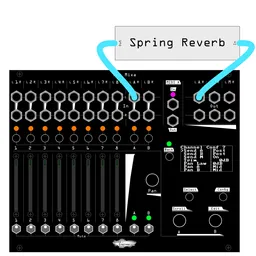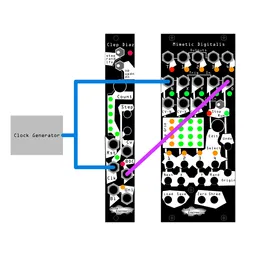Welcome to a new series here on the blog! The four of us here at Noise Engineering all spend a lot of time patching and make use of many Noise Engineering modules in our patches. We’ve found that we often use the same module in very different ways, though. In this series, the four of us will share some of our favorite patches with a particular module. We’ll be kicking things off with Clep Diaz, our classic multimode stepped/smooth CV generator.
Markus: polymeter control
A while back I wanted to create a 13-step long sequence with my Mimetic Digitalis. I could have used another sequencer in my system, but using an entire sequencer just for step-count control of another sequencer felt like a bit much. Clep Diaz to the rescue! I multed the patch clock to the N input on Mimetic Digitalis and Clk input on Clep Diaz. I then patched the BOC output of Clep Diaz to the O input on Mimetic Digitalis, and whatever step count value I dialed in on Clep Diaz (in this case 13) would be the length of the sequence on Mimetic Digitalis. This had the added benefit of generating an ascending step pattern from Clep Diaz that was the same length as my Mimetic Digitalis sequence for even more modulation fun.

Stephen: pattern-tracking smooth random
Clep Diaz’s lfo mode creates a smooth random wave that responds to triggers at the clock input. If you patch a rhythm into the Clk jack you’ll get a smooth random signal that responds to each beat of your rhythm pattern. It will still be a random signal, but changes in direction and level will correspond more closely to the rhythm at the input.
Kris: randomization for humanization
Clep Diaz’s stepped random mode is a perfect tool for making patches sound more natural and less repetitive.
Set the switches to rand and updn. Patch the Uni out to an attenuator like Sinc Defero, and patch to a CV destination in your voice that you’d like to humanize, like a wavefolder or frequency cutoff. Mult the trigger/gate for your voice to CD’s Clk input. Each time your voice is triggered a new random voltage will be generated from Clep Diaz, adding some variation to each note.
When playing an instrument, especially unfretted strings and other instruments with continuous control over pitch, notes won’t always be perfectly in tune. This patch can be paired with a precision adder to create slight offsets in pitch and add a more human element to a CV sequence.
It’s also great on drums: with a live drum kit, consecutive hits on a drum will sound just slightly different. Adding this small amount of variation can add that liveliness.

Patrick:
In this patch, I'm using Horologic Solum as a clock, Loquelic Iteritas as a sound source, Mimetic Digitalis for some stepped CV, and Clep Diaz for CV control of everything else.
Send a fast clock to Clep Diaz with the switches in the step and up positions. Patch the Uni out to Loquelic's Fold, and Bi Out to Pitch B. The BOC output triggers Mimetic Digitalis’s N step input, which in turns sends CV to Loquelic’s Pitch A and Modulate CV inputs, and Clep Diaz's Count CV input. This creates a random, pulsing effect on Loquelic's timbre. The longer Mimetic stays on a step, the brighter Loquelic's tone becomes before switching.
I added the hi-hat sound from BIA to provide a steady beat, balancing out the evolving Loquelic patterns.








